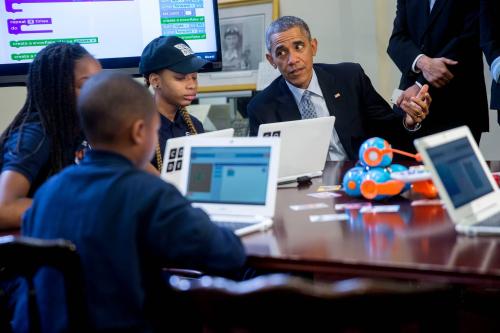For the past dozen or so years, loose consortia of groups from the private and public sectors have been involved in efforts across the United States to enable new pathways “from learning to earning” through the development and use of “digital education credentials.” Such credentials have carried various names over time and continue to do so today. Originally known as digital badges, then micro-credentials or alternative credentials, the consensus term of art today—at least in the United States—is “learning and employment records,” or LERs. To a large extent, work in this area has been heavily influenced and inspired by groups across the United States. Less well-known and understood are the experiences, lessons, and operational contexts from outside the U.S.—especially from Europe—and how these might inform the rollout of LER initiatives across the United States.
Whatever they are called, experts in the field generally agree on the problem that digital education credentials and LERs are meant to help solve and in their promise. The LER Ecosystem Map, a document assembled by key actors in the industry in the United States, challenges us to “imagine a world where everyone is empowered to access learning and earning opportunities based on what they know and can do, whether those skills and abilities are obtained through degrees, work experiences, or independent learning.” In the eyes of proponents, the introduction of LERs can provide a foundational block upon which to build such a world.
This is a compelling vision, to be sure. Despite such inspirational rhetoric and the hard work and evangelism of the many organizations working in this space, widespread use of digital education credentials remains elusive. That’s not to say nothing is happening—according to a leading industry source, over 1 million unique digital education credentials are currently available in the U.S. from a variety of issuers, including those in higher education, “non-academic” training providers, secondary schools, and groups that offer massive open online courses (MOOCs). That’s only the supply side, however. Outside of certain niches with clear need for credentials attesting to competence in highly sought-after technical skills, the LER space is largely characterized by a proliferation of permanent pilot projects that have, collectively, yet to break through and achieve widespread acceptance, recognition, or usage at scale.
What’s the issue, then? Is it a lack of understanding of the tools themselves and their value? Lack of demand from learners and employers? Lack of investment? Do efforts to introduce LERs represent an approach to solving a challenge with a new technology that is, at its heart, not really a technology challenge? Or perhaps related change is complicated and we need to be patient?
Exploring answers across the United States
The SkillsFWD initiative, which supports six state-level LER initiatives, is an attempt to explore answers to these questions. Many of the groups involved in the SkillsFWD projects participate in the T3 Innovation Network coordinated by the U.S. Chamber of Commerce Foundation, which helps to disseminate hard-won insights from real world experiences.
Collectively, it is hoped that these initiatives, and accompanying documentation, research. and evaluation of their approaches and activities, will suggest “pathways to scale for LERs,” as part of larger intentions to “catalyze a more equitable skills-based hiring ecosystem” across the United States. Learning by doing, and learning from each other along the way, is core to these efforts.
What’s happening in Europe, and how this compares to the United States
In addition to learning from approaches being piloted in the United States, there are opportunities to learn from other countries. Related developments in English-speaking countries such as Australia, Singapore, Ireland, and the U.K. are potentially accessible to leaders of LER initiatives in the U.S.—provided they know to look for them. Less well-known for American audiences are developments across non-English-speaking countries in the European Union. In addition to simple language barriers, a lack of familiarity with many processes, approaches, assumptions, and governance structures across Europe can be an impediment to understanding. But this needn’t be the case. While European experiences with “micro-credentials” may not always correspond neatly with circumstances and operational realities in the U.S., rough parallels can be drawn—and key differences may suggest opportunities to mine ongoing, practical experiences across Europe for practical insights of potential relevance in the U.S.
At a high level, here’s a quick overview of the related landscape across Europe and how it compares to that in the United States. Of course, the reality is messier than what is presented here—generalizations can mask nuance, and individual exceptions abound. Viewing activities in Europe through an American lens can lead to some distortions. But, generally speaking, here are:
10 things to know
In Europe, government is more involved in the digital credential agenda—for better and for worse.
Consistent with a more expansive approach to the role of government, there are much tighter linkages between government, the higher education sector, and employers in Europe than there are in the United States. The upside of such coordination is that developments in Europe proceed in a logical manner, informed by consultation with key stakeholder groups, using traditional processes and mechanisms of government. The downside of this approach is that it can be slow, as key actors wait for explicit guidance and regulations from government to sanction what they are doing, and how.
Europe uses the term “micro-credentials” while “learning and employments records” is increasingly preferred in the U.S., but these are essentially the same thing—more or less.
Americans looking to learn from European approaches and experiences in using learning and employment records should be aware that this term is not in widespread use across Europe. (For what it’s worth, “LER” wasn’t commonly used in the U.S. either until an influential paper from the Department of Commerce prioritized its use in 2020.) Moreover, European discussions of “micro-credentials” generally exclude considerations of learning on the job, i.e. the “E” in American conceptions of LERs.
Both regions have largely similar visions and have identified similar challenges.
The visions that animate European and American approaches to the development and use of digital credentials are very similar. Indeed, two elements of the EU’s approach to micro-credentials could well have been borrowed from the LER Ecosystem Map—or vice versa:
(1) the official recommendation of the European Union regarding the potential for micro-credentials to “offer a flexible, targeted way to help people develop the knowledge, skills and competences they need for their personal and professional development,”
and (2) the contention that, if they are to reach their full potential, there are needs for “common standards ensuring their quality, transparency, cross-border comparability, recognition and portability.”
There is a greater focus on higher education in Europe.
Considerations of micro-credential use across Europe focus to a larger extent on the higher education sector than in the U.S., where there is comparably more work being done in the K-12 sector and in ”lifelong learning” outside of formal, traditional education. Across Europe, characterizations of micro-credentials as “alternative credentials” are often because they represent different sorts of credentials offered by higher education institutions, whereas in the U.S., there is a greater diversity of credential providers. Projects such as MICROBOL, which has supported European ministries in exploring how existing European tools and processes can be utilized to support or adapted to enable the use of micro-credentials; MicroHE, which analyzed the impact of modularization, unbundling, and micro-credentialing across European higher education; and MicroCredX, the European Micro-Credentials Exchange, offer insights into how related efforts are rolling out across the continent.
National qualifications frameworks, which don’t exist in the United States, help anchor discussions related to digital credentials across Europe.
National qualifications frameworks (NQF), which classify formal educational qualifications by level based on sets of agreed learning outcomes, are consequential to the development of digital credentials in Europe. The European Union (EU) has convened many related high-level working groups and advisory committees that have proposed roadmaps for action in member states, and work around NQFs increasingly considers the relevance and use of micro-credentials. A common micro-credentials framework proposed by the EU recommends that credentials should be included within an NQF. The U.S. has no such framework (although one is being proposed). That said, the European multilingual classification of skills, competences, qualifications, and occupations (ESCO), which offers structure to help guide the development of digital credentials across Europe, has an analogue in the United States, O*NET. (Work is underway to use artificial intelligence to develop a “crosswalk” between ESCO and O*NET to establish rough equivalencies between different classifications on either side of the Atlantic.)
The European Union is a key actor providing policy recommendations and guidance to member countries, with an eye toward the integration of approaches.
The European Union recommendations related to the use of micro-credentials carry significantly more weight with member national governments than do the recommendations by the Departments of Education and Labor with state governments across the U.S. While official documents such as the European Skills Agenda (2020-2025) may not be binding, the EU Recommendation on a European approach to micro-credentials for lifelong learning offers a blueprint for action of sorts. Guidance to pair efforts supporting the use of digital credentials with state support for individual learning accounts place the use of digital credentials within a broader formal structure of state support for learning within individual European countries. In addition to policy guidance, the EU provides more targeted technical support to member countries around this topic, such as that offered through the affiliated European Training Foundation. Europass is a free set of online tools supported by the European Union to help citizens record all their work, education and training experiences, language skills, digital skills, volunteering experiences, and any achievements that they feel are important.
MOOC providers are key actors in both places.
In Europe, as in the United States, providers of massively open online courses (MOOCs), who are often found outside or adjacent to formal education, are key actors promoting and utilizing digital credentials as a way to certify learning. The Common Microcredential Framework is a collaborative effort by leading European online education and MOOC providers to “unify qualification standards, promoting transparency and cross-border recognition of qualifications within Europe’s higher education institutions.”
European employers have a much greater responsibility for job-related training than do employers in the United States.
In contrast to the United States, where workers are often left to direct their own learning, most job-related training across Europe is employer-sponsored. That said, workers in small and medium-size enterprises, entrepreneurs, and those engaged in occasional work in Europe have less access to job related training, and the state provides comparatively more support for such workers than in the United States. These realities shape the context for the adoption of digital credentials in Europe in key ways in the lifelong learning space.
Government funding for digital credential initiatives is much more consequential across Europe than it is in the U.S.
Given the greater involvement of government in the learning and employment sectors across Europe than in the United States, it is perhaps not surprising that micro-credential efforts across Europe are more dependent on government funding. The disadvantages of this approach are that such funding may depend on related enabling legislation that may not yet be in place, and that state coffers are only so deep. In contrast, digital credential efforts across the United States are funded by a mix of private capital, philanthropic monies, and government funding. This means that related projects can often be initiated more quickly in the United States but may stall if there is not a clear pathway for eventual support by the government, where such funding may be needed for scaling.
European policymakers are more influenced by the work of international organizations related to the use of digital credentials than are their counterparts in the United States.
In addition to guidance from the European Union, which carries obvious weight for national governments across the continent, analytical and advisory work from international organizations is influential with governments in Europe in ways that are not evident in the United States. Documents from UNESCO such as Towards a common definition of micro-credentials and Short courses, micro-credentials, and flexible learning pathways: A blueprint for policy development and action inform—and reflect—related policy discussions across Europe, as does recent OECD work exploring Micro-credentials for lifelong learning and employability. Subsequent OECD analysis of Micro-credential policy implementation in Finland, the Slovak Republic, Slovenia and Spain, performed in partnership with those countries, offers potential insights for groups pursuing similar activities in U.S. states.
Looking forward, from a U.S. perspective
Though the implementation of digital education credentials has lagged across Europe in comparison to similar efforts in the United States, there is nonetheless much that can be learned from such experiences for policymakers, implementing organizations, and practitioners—if they know where to look and how to understand European efforts in ways that are relevant to U.S. contexts. A common challenge across the United States has been how to expand the use of LERs, transitioning from their use in pilot projects to offer new pathways “from learning to earning” at scale. Efforts to date have occurred from the bottom up, with loose consortia of actors banding together to explore a variety of implementation approaches and demonstrate their impact before considering their use at scale. In contrast, European approaches have more intentionally focused on first changing national policies in order to—potentially—enable their use at scale from the start. Understanding the operational contexts and approaches for the rollout of digital education credentials across Europe will be helpful to leaders of American LER initiatives as they look for new ideas and practical know-how to inspire and inform the next phases of LER projects across the U.S.





Commentary
What’s happening with digital education credentials across Europe, from a US perspective
10 things to know
April 25, 2024